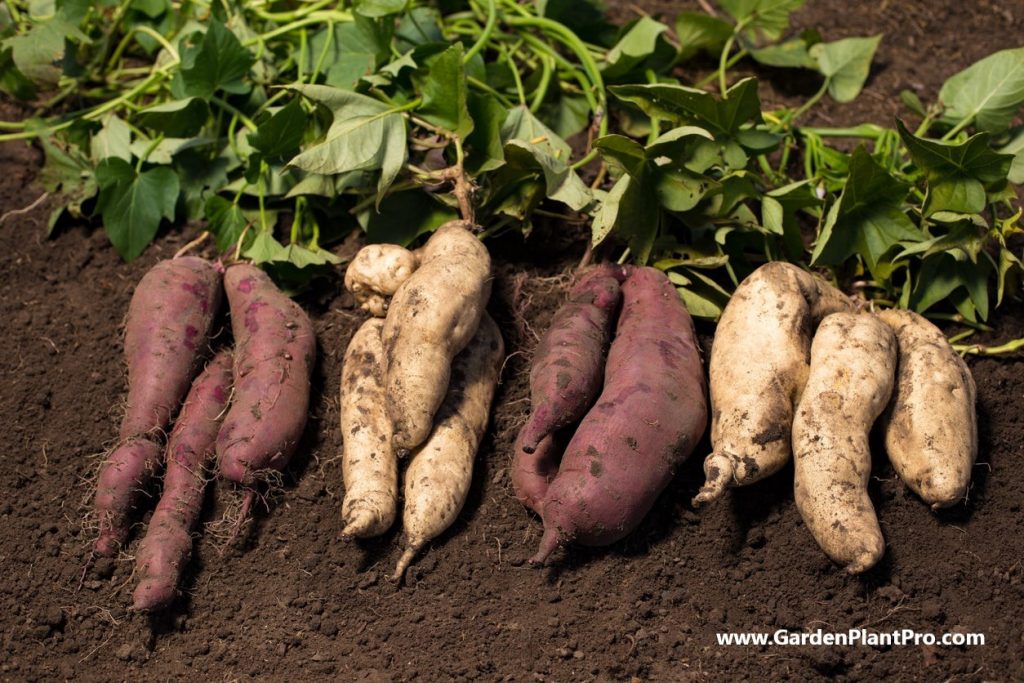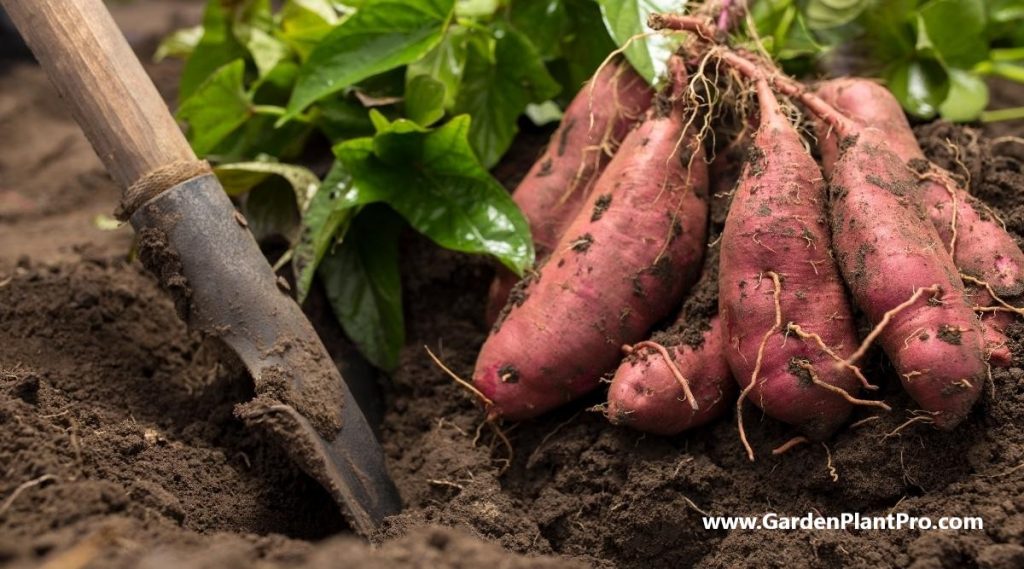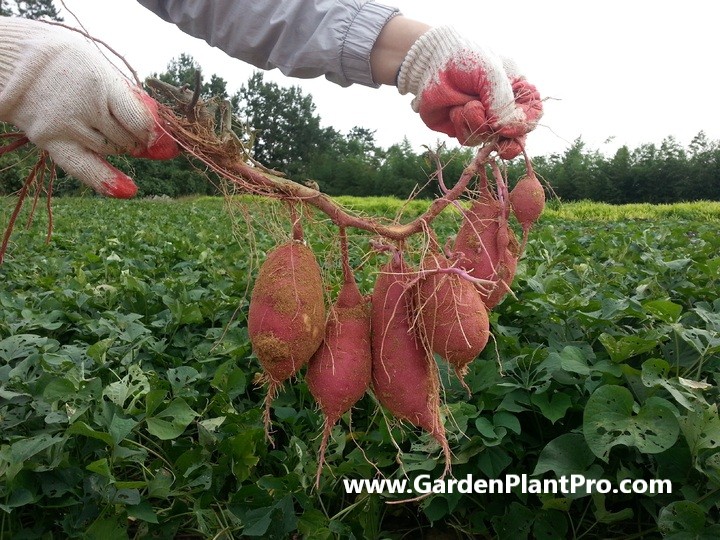Growing your own sweet potatoes can be a rewarding experience – not just for the taste of this delicious root vegetable, but also for the satisfaction of growing your own produce. In this guide, we’ll explore how to successfully grow sweet potatoes in your home vegetable garden.
A Brief History
Sweet potatoes have been a part of our diets for centuries, with evidence of their cultivation dating back to 8000 BC in Peru. As the sweet potato spread across the world, it became a staple crop in many countries. In the United States, sweet potatoes were first planted in North Carolina, and by the late 1700s, they had become a major crop. During the Civil War and World War II, sweet potatoes were used as a food source for soldiers due to their nutritional and calorie-dense properties.
Today, sweet potatoes are grown across the world, but the majority of production occurs in China. Sweet potatoes are highly versatile and can be used in many different dishes from savory to sweet. They are an excellent source of dietary fiber, vitamin C, manganese, potassium and magnesium. They are also a great source of complex carbohydrates which provide sustained energy throughout the day.
When sowing sweet potatoes, it is important to choose a suitable location in the garden that has well-drained soil and full sun exposure. For best results, prepare the soil by adding compost and fertilizers like 5-10-10 before planting slips or seedlings. Once planted, it is important to water regularly and side-dress with fertilizer 3-4 weeks after transplanting. Sweet potatoes will be ready for harvest 8-10 weeks after planting depending on variety. For further tips on growing sweet potatoes at home, lets continue.
Nutritional Benefits
Sweet potatoes are an excellent source of vitamins and minerals, including beta carotene, vitamin C, and potassium. One cup (200g) of baked sweet potatoes provides 4g of protein and 769 percent of your daily recommended intake of vitamin A. Beta carotene is highly beneficial to lung health and an important way to support a nutrient-rich diet. Sweet potatoes are also high in fiber, which can help keep you feeling full for longer.
When it comes to health benefits, sweet potatoes are certainly worth considering as part of your diet. They are not only loaded with vitamins and minerals, but their fiber content can also help regulate blood sugar levels, reduce cholesterol, and aid digestion. Additionally, they are low in calories and fat, making them a great option for those looking to lose or maintain weight.
Whether you choose to grow sweet potatoes at home or purchase them from a store, they can be a great addition to any meal. Try adding them to soups or salads, blending them into smoothies or juices, or simply baking them for a nutritious snack. No matter how you choose to enjoy them, adding sweet potatoes to your diet can provide your body with essential nutrients and help keep you feeling healthy and energized.

Common Varieties & Their Uses
When growing sweet potatoes at home, it is important to choose a variety that is suited to your needs. Sweet potatoes come in a variety of shapes, sizes, and colors, and each has its own unique flavor profile. Some varieties are better suited for baking or boiling, while others are more suitable for steaming or roasting.
The most common type of sweet potato is the Beauregard variety. This variety is characterized by its reddish-orange hue and sweet taste. It is well-suited for baking or boiling due to its slightly soft texture and moister flesh. The Garnet variety is also a popular choice due to its deep orange hue and slightly sweeter flavor than the Beauregard variety. It also holds up better when boiled or baked than other types of sweet potatoes.
The Japanese sweet potato is another popular variety due to its small size and purple skin. The flesh of this type of sweet potato is cream-colored with a slightly nutty flavor. It can be boiled, mashed, or roasted with great results.
The Okinawan sweet potato is one of the most nutritious types of sweet potatoes available. The flesh of this type is deep purple with an almost velvety texture when cooked. It has a nutty flavor that pairs well with savory dishes such as stews and soups.
The Hannah variety has an orange flesh with a slightly moist texture when cooked and a sweet flavor that makes it great for baking or roasting. Its small size makes it particularly well-suited for casseroles and other dishes that require smaller pieces of vegetables.
Finally, the Jewel variety has an orange hue and a creamy texture when cooked. Its sweetness makes it perfect for baking, mashing, or roasting in recipes such as pies and cobblers.
When To Sow
Sweet potatoes are best planted three to four weeks after the last frost, when the soil has warmed up and is dry enough to work. Plant in full sun for best results. Start plants from either cuttings or sweet potatoes (tubers).
For cuttings, bury soft tip cuttings directly into the prepared soil. This should be done 40-50 cm deep. Weed the sweet potato beds regularly starting two weeks after planting.
For sweet potatoes (tubers), use a sterile, sharp knife to cut a full sweet potato in half lengthwise. Bury the halves in the prepared soil 30-45 cm deep and 10-15 cm apart. Water lightly and keep the soil moist until seedlings appear.
Once seedlings appear, thin out overcrowded plants to around 30 cm apart and water regularly, especially during dry spells. Sweet potatoes mature in 90 to 170 days depending on variety and climate conditions, so be patient and enjoy the process!
Choosing A Suitable Location In The Garden
Choosing a suitable location in the garden for growing sweet potatoes is essential for successful production. Sweet potatoes prefer full sun and well-drained soil, so the best location will be one with both of these characteristics.
If you are planting in pots, choose a large container that allows plenty of space for the vines to spread out. Make sure the soil is loose and well-drained and that the pot has good drainage holes.
When planting in the garden, select a site that receives at least 6 hours of direct sunlight each day. If possible, avoid planting near trees or shrubs as they will compete with the sweet potatoes for water, nutrients, and sunlight. If you are growing in an area with heavy clay soils, consider raised beds or mounds to improve drainage and aeration.
DIY PROJECT: Collect rainwater no matter where you live...
This DIY project is the best way to legally collect rainwater NO MATTER where you live. Get chlorine-free water, cut down on your water bills, and have enough for an emergency situation or to water your garden. Read More Here...
When preparing your soil for planting, it is important to use a soil amendment such as compost or peat moss to improve fertility and drainage. Avoid using fresh manure or fertilizers as they can burn the plant’s roots. Once your soil is prepared, you can begin planting your sweet potato slips. Plant them about 12 inches apart to allow enough space for the vines to spread out and produce large tubers.
With proper preparation and care, you can grow healthy and delicious sweet potatoes at home. Choose a sunny location with well-drained soil, prepare your soil with amendments such as compost or peat moss, and plant your slips 12 inches apart to ensure optimum growth and yield.
Preparing The Soil
Preparing the soil for sweet potatoes is key to a healthy and successful crop.
The soil should be deep, around 18 inches, and well-draining. If the soil has a heavy clay content or is too sandy, sweet potatoes may be deformed or long and stringy. To make sure the soil is suitable, it should be amended with organic matter such as compost or aged manure. This will add nutrients and help improve drainage.
To ensure a good harvest, side-dress the sweet potato plants 3 to 4 weeks after planting with 5-10-10 fertilizer. This will provide the plants with essential nutrients for growth and development.
Planting The Seedlings, Tubers or Cuttings
Once the soil has been prepared, it is time to begin planting the sweet potatoes.
When planting seedlings, it is important to space them out by at least 50 cm.
Plant the seeds or seedlings three to four weeks after the last frost in full sun. Sweet potatoes are extremely frost sensitive and mature in between 90-170 days, so be sure to keep this in mind when planning your garden.
For sweet potatoes (tubers), use a sterile, sharp knife to cut a full sweet potato in half lengthwise. Bury the halves in the prepared soil 30-45 cm deep and 10-15 cm apart. Water lightly and keep the soil moist until seedlings appear.
Cuttings are also a great way to start sweet potatoes.
Take a soft tip cutting and bury it in the prepared soil, 40-50 cm deep.
Once planted, water them deeply and keep the soil consistently moist. Consider using mulch around the plants to help retain moisture in the soil and regulate temperatures. Fertilize every two weeks with a high-nitrogen fertilizer for optimal growth and yield. With proper care and maintenance, you can enjoy a bountiful harvest of sweet potatoes from your own backyard.

Caring For The Seedlings
Caring for the seedlings is the key to successful sweet potato cultivation. Seedlings should be watered regularly, but not over-watered as this can lead to root rot. A deep watering once a week is typically enough, but during hotter months more frequent irrigation may be necessary. The soil should be kept moist but not wet.
Fertilizing is also essential for healthy sweet potato plants. Side-dress the plants 3 to 4 weeks after transplanting with a 5-10-10 fertilizer, and then once a month thereafter. If possible, use an organic fertilizer that is low in nitrogen to promote root growth and discourage foliage growth.
In addition to watering and fertilizing, mulching around the base of the plants helps keep the soil moist and prevents weeds from competing for nutrients and moisture. A layer of straw or wood chips applied around the base of the plants works well for this purpose.
Finally, regular pruning of the vines is important to encourage larger tubers and discourage fungal diseases. Prune back any dead or dying vines, as well as any that are crowding other vines or blocking sunlight from reaching the ground below them. Pruning also helps ensure that the plants don’t become top-heavy and topple over in high winds.
Watering & Fertilizing
It is important to water and fertilize sweet potatoes regularly in order for them to grow and develop properly. Water your sweet potatoes regularly throughout the growing season, particularly during dry periods. Aim to provide around 3/4-1 inch of rain per week. Without adequate water, the potato growth will be stunted and you will end up with some small tubers.
Do you have some charcoal in your house right now? We call charcoal a “miracle leftover” for anyone who wants to be a little more self-sufficient and cut costs. That’s because it can help you with so many different things around the house and garden. You can even use it to make an energy-free fridge. Read More Here...
Once established, sweet potatoes will tolerate growing in dry soil but it’s best to keep them evenly moist. If you are after larger tubers, water generously for 7 to 10 days before harvest.
If you are looking for an additional boost of nutrients, apply a high-phosphorus liquid fertilizer once a month throughout the growing season. This should be applied when the plant is actively growing and when rainfall is minimal or absent. Apply it carefully according to the instructions on the product label as over-fertilizing can cause harm to the plant or lead to an imbalance of nutrients in the soil.
When & How To Harvest
Harvesting sweet potatoes is the most rewarding stage of the growing process. When the vines begin to die back and the foliage turns yellow, it’s time to dig up the potatoes. It is best to wait until the soil temperature has dropped below 60°F before harvesting.
Begin by carefully removing any remaining vines. Then use a garden fork or spade to loosen the soil around the plants. Gently lift each potato out of the ground, ensuring that you don’t damage them with the tools.
Handle sweet potatoes carefully as they bruise easily and can spoil quickly if damaged. Once harvested, keep them in a cool, dry place away from direct sunlight. Cure them for several weeks at temperatures between 85°F and 95°F with high humidity to improve their storage potential and sweetness.
When properly stored, sweet potatoes can last for several months. They can be kept in a cool, dark place or wrapped in newspaper and stored in a cardboard box in a cool basement or garage. Make sure to check on them periodically for any signs of spoilage and discard any potatoes that have become soft or discolored.

Storing & Preserving
Storing and preserving sweet potatoes is an important part of the growing process.
After harvesting, the potatoes must be cured for several days in a warm, humid environment. This helps to toughen up the skins and allows them to store better. Once they are cured, they can be stored in an ideal location that is dark, cool, and humid – such as a root cellar, garage, or basement.
When selecting a storage location for sweet potatoes, it is important to choose one that is dry and well-ventilated. The ideal temperature for storing sweet potatoes is around 55°F with humidity levels of around 60%. Sweet potatoes should be kept in a breathable container or mesh bag for best results.
Sweet potatoes should not be left in direct sunlight or exposed to temperatures above 60°F as this can cause them to spoil quickly. It is also important to avoid stacking the potatoes too closely together as this can lead to rot and disease. Properly stored sweet potatoes can last up to six months without loss of quality or flavor.
Before eating your home-grown sweet potatoes, it is important to inspect them for any signs of rot or disease. If you see any discolored spots or soft spots on the skin, discard them immediately as they will not be edible. By following these simple steps, you can enjoy your home-grown sweet potatoes all winter long!
Common Diseases & How To Control Them
Sweet potatoes are prone to a number of diseases, including Fusarium wilt, bacterial soft rot and black rot. To help prevent sweet potato disease, start with disease resistant varieties and healthy slips. Planting in well-draining soil, providing adequate levels of light and water, and avoiding over-fertilizing are all important for preventing disease.
Fusarium Wilt
Fusarium Wilt is a fungal disease that affects the plant’s vascular system and causes wilting and yellowing of the leaves. To control Fusarium Wilt, choose resistant varieties, keep the area around the plants free of weeds and debris, avoid overcrowding plants, and rotate crops on a regular basis.
Bacterial Soft Rot
Bacterial soft rot is caused by several species of bacteria that attack the tubers and cause them to rot. The best way to control bacterial soft rot is to choose healthy slips or seed potatoes, avoid overcrowding plants, water plants only when necessary, and practice good hygiene when harvesting and handling sweet potatoes.
Black Rot
Black rot is caused by a fungus that affects the stems and leaves of sweet potatoes. To help prevent black rot, choose disease-resistant varieties, avoid overcrowding plants, water only when necessary, avoid excessive fertilization, and rotate crops on a regular basis.
Common Pests & How To Control Them
Common pests can be a nuisance for sweet potato growers, as they can cause significant damage to the crop. To help protect your sweet potatoes, it is important to be aware of the most common pests and how to control them.
The most common pest that affects sweet potatoes is the sweet potato weevil. These small, black weevils are about 1/4 inch in length and feed on the root system of the plant. They can cause significant damage to the roots, reducing yields and making plants more vulnerable to disease.
CASE STUDY: We've been living off the grid for the last 40 years...
In all that time an electric wire has never been connected to our house. We haven’t gotten or paid an electricity bill in over 40 years, but we have all the electricity we want. We grow everything we need, here, in our small backyard. We also have a small medicinal garden for tough times. Read More Here...
To control sweet potato weevils, use a recirculating duster to apply Imidan dust at 5% concentration at harvest time. This dust will kill any adult weevils that are present and will help prevent them from spreading further.
Other common pests that affect sweet potatoes include aphids, thrips, flea beetles, cutworms, and whiteflies. All of these can be controlled through natural methods such as companion planting with certain herbs and flowers that attract beneficial insects like ladybugs or lacewings which feed on these pests. You can also try using natural oils like neem oil or insecticidal soap spray to control them directly.
It is also important to practice crop rotation, as this can help disrupt pest cycles and prevent them from becoming established in your garden. Planting in raised beds with well-drained soil material may also help reduce pest infestations by making it harder for them to survive in your soil.
Beneficial Companion Plants
Once you have chosen and prepared the area in which to plant your sweet potatoes, it is important to consider companion plants. Companion planting is a natural way to encourage healthy plant growth, ward off pests and diseases, improve flavor, and maximize space in your garden.
Root vegetables, such as parsnips and beets, are good companion plants for sweet potatoes. They help keep the vines pest-free. Other beneficial companion plants for sweet potatoes include onions, garlic, lettuce, celery, oregano, marigolds, nasturtiums, and spinach.
Onions attract beneficial insects that prey on pest insects and their strong scent can also help repel certain pests. Garlic helps repel aphids and other insect pests as well as some fungal diseases. Lettuce can be planted between rows of sweet potatoes to provide shade to the soil and reduce moisture loss. Celery has a strong scent that may help repel some insect pests.
Oregano is a natural insect repellent that may also help improve the flavor of your sweet potatoes. Marigolds are known for their ability to repel nematodes and other pest insects. Nasturtiums attract beneficial insects and may help repel aphids and other pest insects. Spinach can be planted between rows of sweet potatoes to provide shade to the soil and reduce moisture loss.
When selecting companion plants for your sweet potatoes it is important to choose plants that will help protect them from pests and diseases. Be sure to research any potential companion plants that you plan on planting in order to ensure that they will not interfere with the growth of your sweet potatoes or compete for nutrients in the soil.
Additionally, avoid planting any companion plants that may be attractive to the same pests or diseases as your sweet potatoes as this could potentially lead to infestations or outbreaks of disease in your garden. With careful selection and placement of companion plants you can maximize the health benefits of growing sweet potatoes in your garden.

Using Your Home Grown Sweet Potatoes
Once your sweet potatoes have been harvested, it is time to enjoy the fruits of your labor! Sweet potatoes can be cooked and enjoyed in a variety of ways. They can be boiled, baked, mashed, fried, and even made into desserts. They can also be eaten raw, diced into salads or cut into thin slices for chips.
When cooking sweet potatoes, the skins should be left on for additional nutrition and flavor. Boiled sweet potatoes can be mashed with butter or olive oil and seasoned with herbs and spices for a tasty side dish. Baked sweet potatoes are best when stuffed with savory ingredients such as cheese, bacon, onions, and seasonings.
Fried sweet potato slices make a delicious snack or side dish. To make them crispy on the outside yet tender inside, slice the potatoes into thin rounds and coat with a light batter before frying in hot oil until golden brown. Sweet potato chips can also be prepared in this manner by seasoning the batter mixture prior to frying.
Sweet potatoes are also great for making delectable desserts! When cooked until very soft, they can be blended into smoothies or used to make breads and cakes. They can also be cubed and roasted for a sweet treat that is healthy as well as delicious!
In addition to eating them fresh from the garden or cooked in various ways, home-grown sweet potatoes can also be stored for long-term use. After harvesting, allow them to cure in a warm place for 2-3 weeks before storing in cool dry place such as a root cellar or pantry shelf. Properly stored sweet potatoes will last up to 8 months.
No matter how you choose to enjoy your home-grown sweet potatoes – fresh from the garden, cooked in various dishes, or stored for future use – you are sure to reap the nutritional benefits provided by this versatile vegetable!




